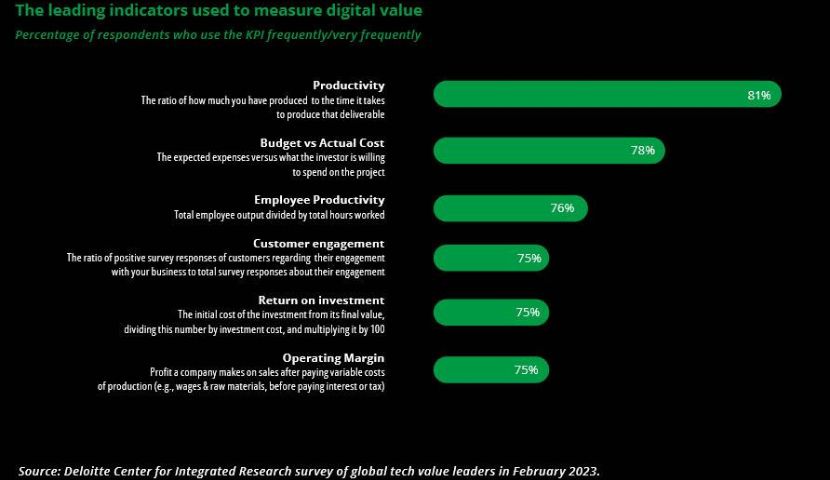Digital transformation is a major driver for success in manufacturing and distribution organizations. While digital transformation is integrating new digital technologies into your operations, changing the foundation of how things are done, you cannot completely tell the benefit of your digital transformation initiatives without measuring their impact and determining whether they are achieving the set objectives.
Measuring the impact of digital transformation initiatives allows your organization to assess whether you are getting the expected returns—such as increased efficiency, operational costs reduction and enhanced product quality—from the project. Also, through measuring the impact of your digital transformation initiative, you get to know areas that need to be optimized further to ensure your digital transformation success.

Digital Transformation Checklist
Download the eBook to discover how to navigate the complexities of digital transformation while you drive lasting change within your organization.
The Impact of Tracking Digital Transformation KPIs
What are Digital Transformation Metrics?
Digital transformation metrics refer to the quantifiable measures that your organization can use to assess the success and impact of your digital transformation initiatives. Digital transformation metrics are crucial in alerting you whether your digital transformation efforts are effective and in-line with your business objectives. Tracking the right metrics allows your business to get an in-depth understanding of the performance of your digital transformation tools—such as enterprise resource planning (ERP) systems.
“As organizations launch more and more digital initiatives, CEOs must monitor whether they are delivering business results. These metrics are ones to watch.”
Matt Fitzpatrick, McKinsey Digital
Output Metrics Vs. Outcome Metrics
To measure digital transformation success, your organization can use output and outcome metrics. These two are different and should be distinguished from one another. Output metrics focus on the immediate results, such as number of business processes automated and percentage of employees trained to use the new system. Outcome metrics focus on measuring tangible benefits that your digital transformation journey brings, such as increased revenue and improved customer engagement and satisfaction.
Why are Metrics Important in Digital Transformations?
Key performance indicators (KPIs) and metrics provide a framework that your organization can use to evaluate the progress of your digital transformation initiatives in order to make informed decisions. Your organization can use digital transformation KPIs to determine whether the digital investments are delivering the expected results and identify areas that can be optimized to maximize on the benefits. With KPIs, your organization can refine the implemented strategies, allocate resources needed for success and ensure that the digital transformation efforts remain aligned with your business objectives.
Digital transformation KPIs are also crucial in driving continuous improvements in digital transformation tools, such as ERP systems. By tracking the performance of various processes and functions, your company can identify bottlenecks, inefficiencies and areas where digital technologies can be used to streamline operations. Utilizing a continuous approach is crucial in unlocking the full potential of your ERP systems, which places you on top of your competitors in the current competitive digital space.
Ready to start your digital transformation journey?
Click the button below to request your free discovery call.

Key Metrics for Digital Transformation
1. Business Outcomes
Measuring digital transformation success allows your organization to evaluate whether the digital transformation initiatives contribute to achieving your business goals and objectives, such as increased revenue, improved profitability, enhanced customer satisfaction and expanded market share. Aligning your digital transformation KPIs with your business goals ensures that your digital technology investments are delivering tangible value.
Establishing clear, measurable targets and tracking progress against your goals helps assess the impact of the digital transformation initiative on your business outcomes.
“Digital transformation metrics should capture how well the digital transformation drives business outcomes, which initiatives deliver value, and how well the organization adapts its culture and operating models.”
Isaac Sacolick, CIO
2. Operational Efficiency Metrics
The major aims for digital transformation initiatives include streamlining processes, reducing operational costs and improving operational efficiency. This makes operational efficiency one of the most important digital transformation metrics to assess. Your organization can measure the impacts of your digital transformation initiatives by tracking operational efficiency metrics, such as process time reduction, cost savings and automation rates. Quantifying the efficiency improvements allows your organization to get a clearer picture of your digital investments.
For example, implementing a warehouse management system (WMS) in your organization can help with optimizing inventory levels and improving order fulfillment accuracy. You can measure metrics, such as inventory turnover, order pick accuracy and on-time delivery rates to assess how effective the new WMS system is. You can also calculate the cost savings that your organization gets by measuring the reduction in inventory holding costs and the improvement in customer service.
“Count the number of processes that now run on new software and how it has affected productivity (a.k.a. the volume or value of outputs relative to the resource investment). This will give you some insight on the overall level of adoption and usability.”
Forbes Expert Panel
3. Customer Experience Metrics
We live in a customer-centric business environment, and every customer expects to have an exceptional experience. The implementation of digital transformation initiatives focuses on improving the customers experiences to increase customer loyalty. To measure the impact of your project on customer experience, your company can track metrics, such as customer satisfaction scores, user engagement rates and digital interaction quality.
Implementing a customer portal can help provide easy access to order status, product information and support resources. Assessing the effectiveness of the portal in improving your customers’ experiences can be done by monitoring customer satisfaction scores and analyzing the user engagement data. Also, your organization can track customer related metrics, such as resolution time and first contact resolution rates to identify areas that can be further improved to promote high quality digital interactions.
4. Employee Productivity and Engagement Metrics
A recent Deloitte study cited, “81% of respondents use productivity as the prime measure of digital transformation ROI.” For your digital transformation initiative to be successful, your employees must adopt the new processes and systems, and use them in their day-to-day work. To measure the impact of your digital journey on your employees, evaluate employee satisfaction, adoption rates and employee productivity metrics. These metrics are crucial in ensuring that your organization can identify areas where employees need to be trained further to ensure successful adoption of the new processes and systems.
Training is a crucial strategy to increase user adoption rates. But, even before the training phase, get your employees involved in every aspect of the digital transformation initiative. This makes them “own” the systems, and they feel that their voices matter when it comes to crucial investments—which significantly increases the new technologies and processes adoption rates. You can also measure the success of your training programs by analyzing metrics, such as completion rates, knowledge retention and application of new skills.
Active usage metrics can help you identify any issues in your systems and inform you how well users engage with the digital technology. Key metrics can be tracked, such as the number of users logging into the system and the percentage of times that a task is started and completed.
5. Digital Capabilities and Advancements
Assessing the impact of the digital transformation initiatives on your organization’s technological capabilities is also crucial. Digital transformation KPIs to track include infrastructure improvements, system enhancements and tool adoption.
For example, the implementation of a cloud-based ERP system can help your organization improve scalability, flexibility and data accessibility. To analyze whether this investment was worth it, your organization can track KPIs such as system uptime, data processing speed and user adoption rates to assess the impact of the system on your organization.

Financial Impact from Digital Transformation
1. ROI and Cost-Benefit Analysis
To justify your digital transformation initiative, your company needs to understand the financial impact of the project and its long-term sustainability. One crucial KPI for assessing the financial impact of your digital transformation strategy is return on investment (ROI). Your organization can calculate the ROI of the project by comparing the costs of implementing the digital tools with the financial benefits the tools offer, such as increased revenue, cost savings and employee productivity gains.
Using the cost-benefit analysis (CBA) method can also be used to evaluate the financial impact of digital transformation initiatives. This method weighs the anticipated benefits against the costs that the project will incur. The CBA method gives your organization all the necessary information needed to make informed decisions about which digital initiatives should be prioritized.
2. Revenue growth
Any digital transformation initiative can have an impact—direct or indirect—on your company’s revenue growth. Direct impact can be measured using metrics, such as sales growth, market share and customer acquisition rates to assess the effectiveness of the project in driving growth in your organization.
Measuring indirect impacts—such as improved employee engagement and data-driven decision making—can be difficult. Indirect impacts can be measured by assessing KPIs, such as customer satisfaction, brand loyalty and referral rates.
Measuring Innovation and Growth
1. Market Share and Competitive Positioning
Digital transformation initiatives can also help your organization expand your market share, improving competitiveness. Your organization can measure the impact on these efforts using metrics, such as market share, customer retention rates and brand perception. Analyzing the changes in these indicators over time can help assess whether your digital initiatives are effective in driving your market leadership and differentiation.
Monitoring your competitiveness post implementation is also crucial. Your organization can assess this by tracking metrics such as competitor pricing, product offerings and customer satisfaction. Also, staying on top of emerging and disruptive technologies is crucial in ensuring that your digital transformation efforts remain aligned with the evolving needs of the market.
2. New Product Innovations and Upgrades
Driving innovation and accelerating the development of new products and services can be a game changer for your organization. Digital transformation initiatives play an important role in this, and you can measure metrics such as time-to-market, product development cycle time and the number of new products launched to assess their impact.
Digital agility allows your organization to respond swiftly to market demands and seize new opportunities. You can assess your organization’s ability to respond quickly to changing market conditions by tracking metrics such as the speed of decision-making, the adaptability of processes and the adoption of new technologies. Also, monitoring customer feedback and market trends can help you provide products that align with your customers’ evolving needs and preferences.
How to Choose the Right KPIs for your Digital Initiative
To effectively measure and assess your digital transformation initiative, choosing the right digital transformation KPIs is crucial. We have looked at many KPIs your organization can use to measure and assess the impact of your digital project. However, the KPIs you select must be directly linked with your organization’s goals and objectives.
Having a partner—such as Ultra Consultants—can help your business select metrics that can provide you with a clear picture of your digital transformation initiatives. Digital transformation consultants play a crucial role in assessing your organization’s current digital maturity, define your digital transformation goals and objectives and select KPIs that will provide valuable insights into your progress and performance.
Selecting the KPIs is just the first step in assessing your digital transformation projects. Establishing a system for tracking and collecting data is also necessary and may involve implementing new digital tools and technologies such as data analytics platforms, IoT sensors and machine learning algorithms.
Conclusion
For companies that are looking to stay competitive, measuring the impact of digital transformation initiatives is crucial. Tracking the right key performance indicators (KPIs) in the key areas, such as operational efficiency, customer experience, employee engagement and financial performance, can provide your business with valuable insights into how effective your digital transformation is in addressing your unique needs. Selecting the right KPIs requires that you understand your organization’s objectives, needs and digital maturity level.
Ultra Consultants understands the importance of staying ahead of your competition and delivering exceptional customer experiences to your clients. Our experts can help your company stay on top of digital transformation trends and developments in your specific industry—whether manufacturing or distribution. We ensure that your digital transformation journey delivers the expected ROI and aligns with your business strategy.
Get started today on your digital transformation journey. Request your free discovery call here.
Table of Contents
More ERP material...
AI in Food and Beverage Manufacturing
Discover how AI is revolutionizing food and beverage manufacturing, enhancing quality, reducing…
How ERP for Quality Control Eliminates Manual Documentation Chaos
This post will examine why managing quality records outside of an ERP…
Assessing Your AI Maturity
This article breaks down how businesses can measure their AI maturity to…



